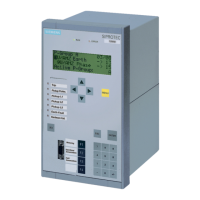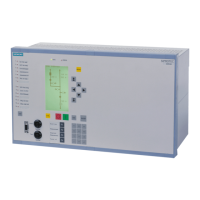Overcurrent protection (optional)
The device 7VK61 features a time overcurrent protection function with four independent stages that can be
combined freely with one another.
General
The overcurent protection has a total of 4 stages for each phase current and four stages for the earth current,
these are:
•
2 overcurrent stages with a definite time characteristic (O/C with DT),
•
1 overcurrent stage with inverse time characteristic (IDMT),
•
1 additional overcurrent stage which is preferably used as a stub protection, but which can be applied as
an additional normal definite time delayed stage. With the device variants for the region Germany (10th
digit of ordering code = A) this stage is only available if the setting 126 TOC IEC /w 3ST is active.
These 4 stages are independent from each other and are freely combinable. Blocking by external criteria via
binary input is possible as well as rapid (non-delayed) tripping (e.g. by an external automatic reclose device).
During energization of the protected feeder onto a dead fault it is also possible to release any stage, or also
several, for non-delayed tripping. If you do not need all stages, each individual stage can be deactivated by
setting the pickup threshold to ∞.
Functional Description
Measured Values
The phase currents are fed to the device via the input transformers of the measuring input. Earth current 3·Ι
0
is either measured directly or calculated depending on the ordered device version and usage of the fourth
current input Ι
4
of the device.
If Ι
4
is connected to the starpoint of the current transformer set, the earth current will be available directly as
measured quantity.
If the fourth current input Ι
4
is not connected as earth current transformer, the device will calculate the earth
current from the phase currents. This requires, of course, all three phase currents from a set of three star-
connected current transformers to be available and connected to the device.
Definite time high set current stage Ι>>
Each phase current is compared with the setting value Iph>> (address 2610) the earth current is compared
with 3I0>> PICKUP (address2612). A trip command is issued after pickup of an element and expiration of
the associated time delays T Iph>> (address 2611) or T 3I0>> (address 2613). The dropout value is about
7 % below the pickup value, but at least 1,8 % of the rated current.
The figure below shows the logic diagram of the Ι stages. They can be blocked via binary input
>BLOCK O/C
I>>
. The binary input
>O/C InstTRIP
and the function block “switch-onto-fault” are common to all stages
and described below. They may, however, separately affect the phase and/or ground current elements. This is
accomplished with the following setting parameters:
•
I>> InstTrip BI (Address 2614) determines whether a non-delayed trip of this element via binary
input
>O/C InstTRIP
is possible (YES) or not possible (NO) and
•
I>> SOTF (address2615) whether during switching onto a fault tripping shall be instantaneous (YES) or
not (NO).
2.3
2.3.1
2.3.2
Functions
2.3 Overcurrent protection (optional)
SIPROTEC 4, 7VK61, Manual 69
C53000-G1176-C159-5, Edition 05.2018

